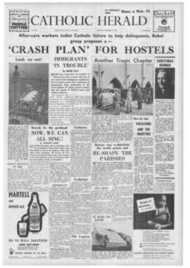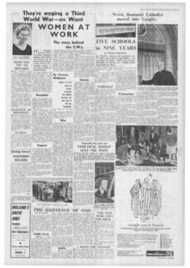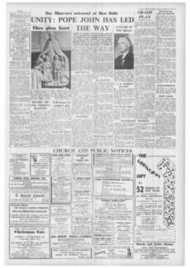Page 3, 24th November 1961
Page 3

Report an error
Noticed an error on this page?If you've noticed an error in this article please click here to report it.
Tags
Share
Related articles
Mr. Walter Kolarz
The Church's War Years
Godless Russia
Soviet Authorities Are Resorting To Thuggery Against...
'god Among The Godless
A BEACON OF HOPE IN THE U.S.S.R.
goo. By Haw.. ...
Henderson
RELIGION IN THE SOVIET UNION, by Walter Kolarz (Macmillan, SOs.).
nNLY a handful are left of
the many Catholic churches which existed in Tsarist times throughout the Russian Empire, outside the areas with a cornpact Catholic population. The most important of these is the Church of St Louis des Francais in Moscow, founded in the reign of Catherine IT and completed under Alexander I.
Situated in the very heart of the Soviet capital it has a tremendous significance for Catholicism in the Soviet Union and was for a long time the only link between the oppressed Catholics of Russia and the Universal Catholic Church.
Influence
vET at the beginning of the first world war the Catholic Church was firmly established in many parts of the Russian Empire. Throughout European Russia— from Polotsk. Vitebsk and Mohilev in the West. to Orenburg and Ufa in the East, from Archangel in the north to Vladikavkaz in the south —there was hardly a large town without its Catholic church or chapel. Even in Russian Asia there were Catholic churches in major urban centres.
These facts are revealed by Walter Kolarz in " Religion in the Soviet Union ", a work of immense research covering the story not only of the larger churches in Russia but even smaller religious groups like the Seventh Day Adventists and Jehovah's Witnesses.
How the Soviet authorities have tried deliberately to break the power and influence of the Catholic Church in Russia and her occupied territories, despite the Communist pretence that religious
freedom is guaranteed by the Constitation, is graphically recounted in Mr. Kolarz's pages.
Realisation Resistance
BUT, as Mr. Kolarz observes, " the day was to come when Stalin realised that the Pope had 'divisions' after all ... he realised this when Soviet Russia came into physical contact with Catholic countries and especially with Poland, the most staunchly Catholic of all the territories which the Red Army occupied in pursuit of the retreating Nazi forces ".
The brave resistance of priests and people in Russia's newly won Catholic territories fill some of the most insp;ring pages of this book.
Will religion survive the struggle with Communism, which has made no secret of its intention to destroy it?
Mr. Kolarz has no doubts on the matter. Throughout Soviet history, he says it has remained the most visible ideological alternative to Communism —the only opponent of Communism able to preserve at least some of its institutional forms. The Holy Scriptures of the great religions will still be read and studied when men
remember only the titles of some of the so-called Communist classics.
Phenomenon
FEW will disagree with the author's conclusion that "Nowhere in the vast Soviet Empire can the Communist regime be truly popular as long as it fails to recognise that religion is a genuinely popular phenomenon, deeply rooted in the soul and traditions of every people. To be really free, a nation needs more than schools, libraries and literature in its mother tongue; it needs spiritual freedom, free access to its holy places, the recognition of its religious heritage and its national church"
blog comments powered by Disqus









